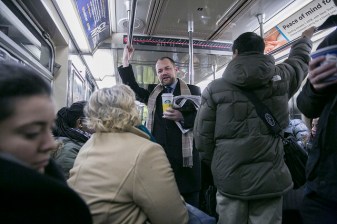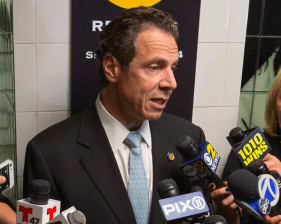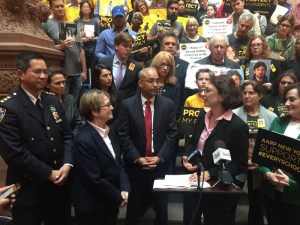Graphed: Support for Congestion Pricing Depends on How You Frame It
Toward the end of last week, City Council speaker and current 2013 mayoral frontrunner Christine Quinn set off a burst of transportation policy buzz when she said she still supports congestion pricing but doesn’t expect it to get revived in Albany.
Remember, though, that while risk-averse Albany electeds may try to preemptively dismiss road pricing as politically impossible, public support for the idea is actually quite strong when it’s framed as a way to fund transit, according to a series of Quinnipiac polls conducted in 2007 and 2008.
Capital New York’s Azi Paybarah has done a huge service by graphing the results of those Q poll congestion pricing questions. When the policy was framed as “charging vehicle owners a fee to drive below 60th street in Manhattan during rush hours,” support tended to fall below 40 percent. But support surged when the pollsters asked, “Would you support congestion pricing if the money were used to prevent an increase in mass transit fares and bridge and tunnel tolls?”
Here’s his graph of the percent support for congestion pricing in response to the different questions:

Paybarah notes that the last two polls, in January and March of 2008, used another variation on the question instead of the “preventing fare hikes” angle. This question asked simply, “Would you support congestion pricing if the money were used to improve mass transit in and around New York City?” (Any road pricing plan would likely pay for transit improvements by funding the MTA’s capital program, and keep fares lower by reducing the amount of capital spending that’s covered by fare-backed debt.)
Paybarah incorporates the change of language into this graph of how Democratic voters responded to the Q polls:

The other critical piece of public opinion data about congestion pricing (which we regrettably have to get from outside NYC), is that support shoots up dramatically after implementation. In Stockholm, a survey found opposition to congestion pricing at 80 percent before a six-month trial was implemented in 2006. After the trial, 53 percent of city residents voted to keep it in place in a public referendum. In London — where a single elected official, mayor Ken Livingstone, championed the policy in the face of protests and media doomsaying — public support for the program stood at 70 percent three years after implementation.


